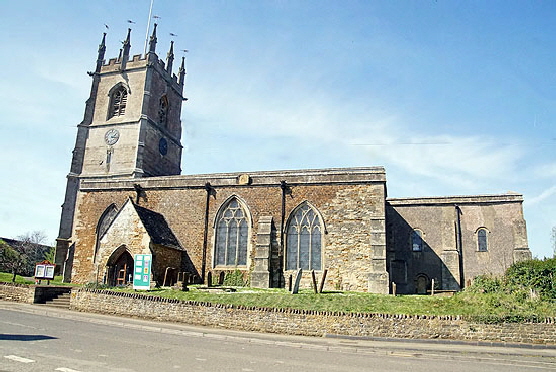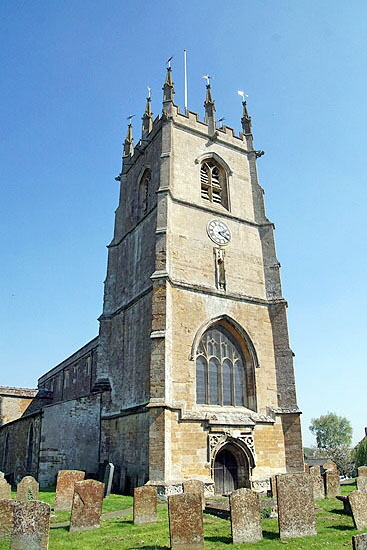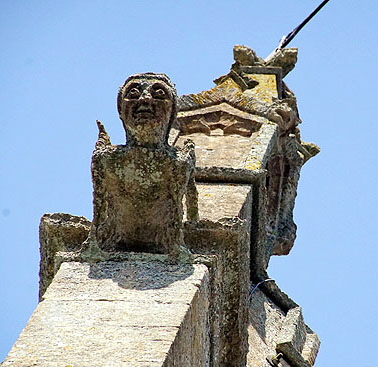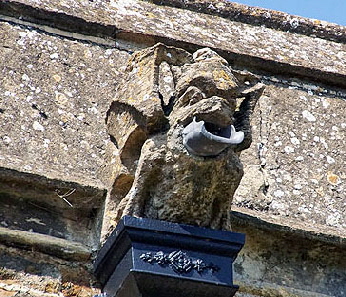|
Alphabetical List |
|
|
|
|
|
|
|
County List and Topics |
|
|
|
Please sign my Guestbook and leave feedback |
|
|
||||||||||||||||||||||||||||
|
signs of that today. Nevertheless, the village - then Hoernatune - was mentioned in the Anglo-Saxon Chronicles in AD922 so it seems quite likely that for once the supposition of a pre-Norman foundation is not in this case historical wishful thinking. Nevertheless, we are dealing with a church that to all intents and purposes Norman in origin. The chancel is mainly original Norman and Pevsner remarked that it was of such a size as to indicate that this always was a big church. There were transepts either side of this chancel such that the whole structure was cruciform. The north transept is still largely in its original form and there was also a chapel to the east of it. The south transept was rebuilt in Decorated style and a south aisle was made contiguous with it. We do not know whether the Norman church itself has aisles. We have to assume that the present nave was based upon a Norman original but we do not know how far it extended to the west. Pevsner puts the arcades of the north aisle as thirteenth century in the transitional period between Early English and Decorated styles. The south aisle looks later. In the fifteenth century the west tower was added in Perpendicular style. We must speculate that it is likely to have replaced a Norman tower, given the relatively large proportions of the Norman church. Given that the base of that tower - if there was one - was not reused it seems quite likely that the church was also extended a little to the west. The tower itself with its battlements. pinnacles and gargoyles contrasts favourably with the somewhat tatty exterior of the rest of the church! But it looks wrong. The chancel arch is fourteenth century and there are signs of the imposts from it Norman predecessor. Above that are well-preserved fifteenth century wall paintings. The painting was interrupted by the addition of an eastern nave window, a device sometimes known as a “Cotswold Window” as it is even more uncommon outside this area. The Church Guide says that the only other in the county is at Chipping Norton but the best-known example, perhaps, is at Northleach in Gloucestershire. That, however, is still in the Cotswolds! I know I have seen exceptions that are outside the Cotswolds but it’s a nice name, isn’t it? |
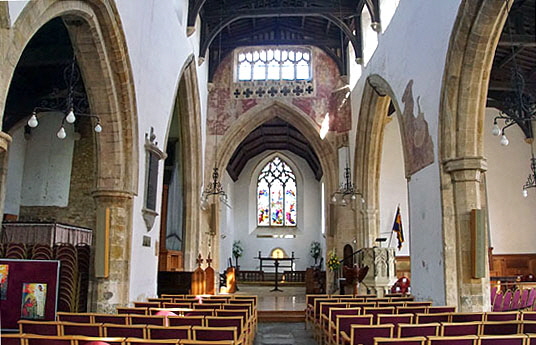 |
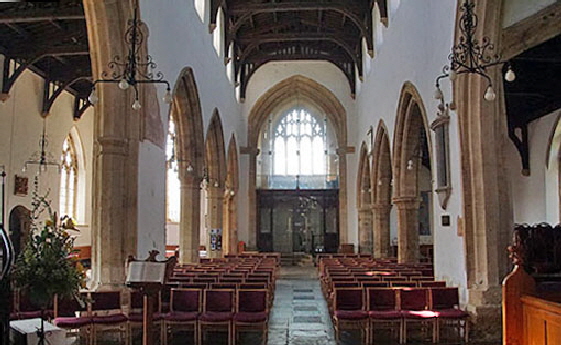 |
|
Left: Looking towards the east end. The exterior of the church may appear unenticing but the interior makes a real impact. There is a real feeling of height, doubtless enhanced by the unusual “Cotswold Window” (I love that term and shall use it in future!) that sits squarely in the middle of the wall painting. The feeling of height is enhanced by the somewhat narrow nave - compare it with the south aisle to the right. The removal of the chancel screen did this church something of a favour, I feel. Note the taller and more elegant piers of the south aisle compared with its slightly earlier northern counterpart. The east window is elegant Decorated style - and original. Right: Looking west we see the Perpendicular style west window illuminating the nave via a really hefty tower arch. |
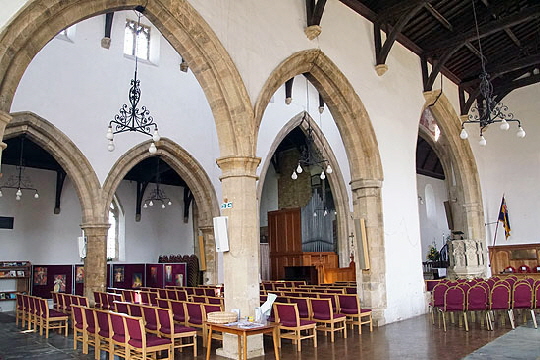 |
|||||||||||||||||||
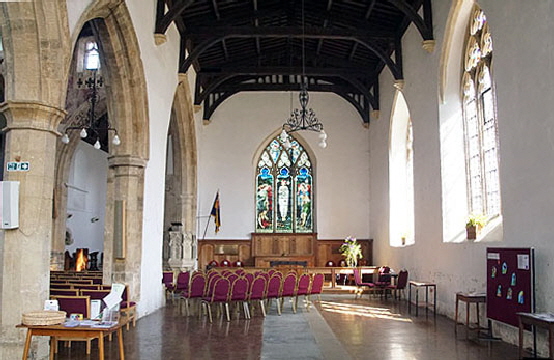 |
|||||||||||||||||||
|
Left: The south aisle is very wide. Again, the window is in Decorated style and Hook Norton is a good place to contrast the lovely tracery designs of this style with the mass-produced and regimented styles of the Perpendicular west and Cotswold windows. Right: Looking across the south aisle to the north east. The fifth bay on both aisles are larger and separated from the rest of the arcades. These were the arches to the transepts. Note the clerestory with rectangular windows. |
|||||||||||||||||||
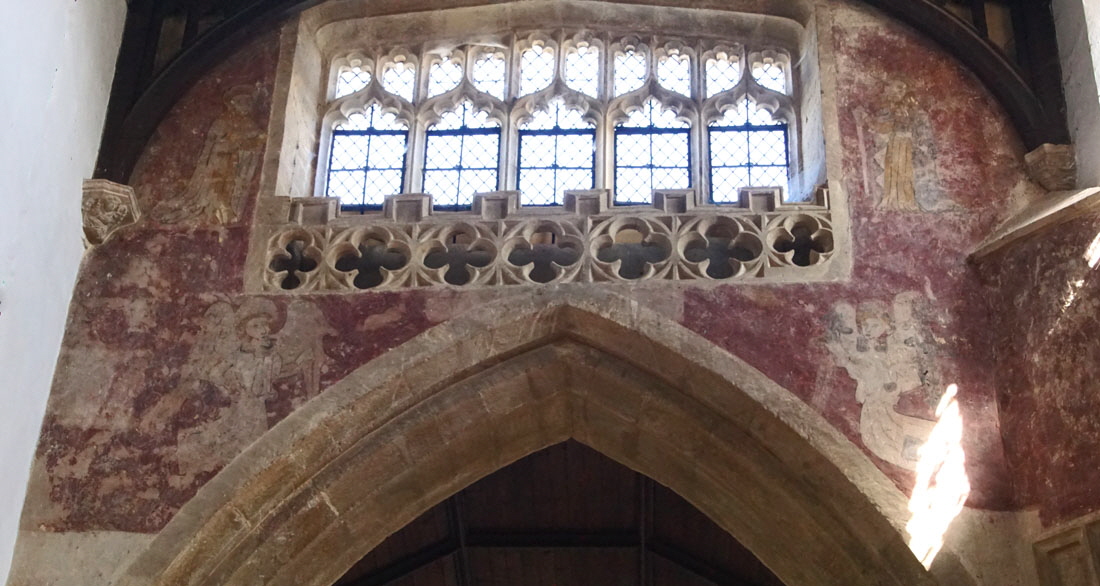 |
|||||||||||||||||||
|
The Cotswold Window and the fifteenth century wall painting. SS Peter and Paul are to left and right at the top. Angels with censers are either side of the arch. I presume that Christ in Majesty was where the window now is. The paintings were covered up with limewash at the Reformation, needless to say, and that event probably predated the window. It seems that the parishioners of Hook Norton were spared the usual display of Judgement, Damnation, Devils and so on. |
|||||||||||||||||||
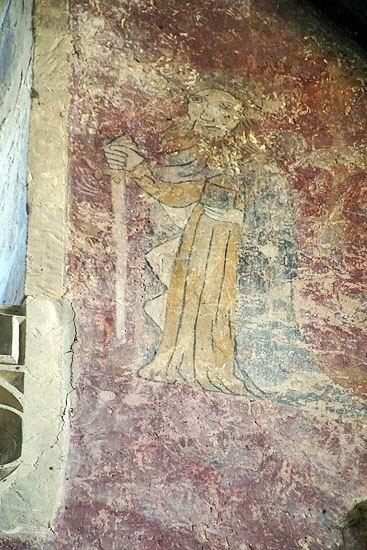 |
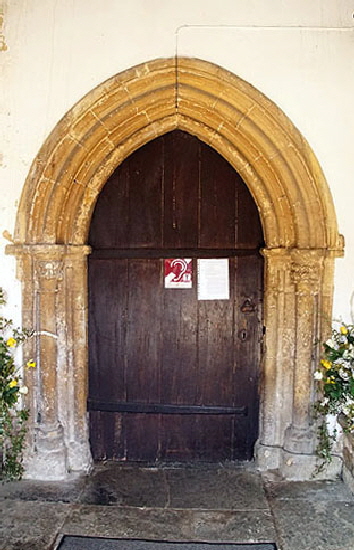 |
||||||||||||||||||
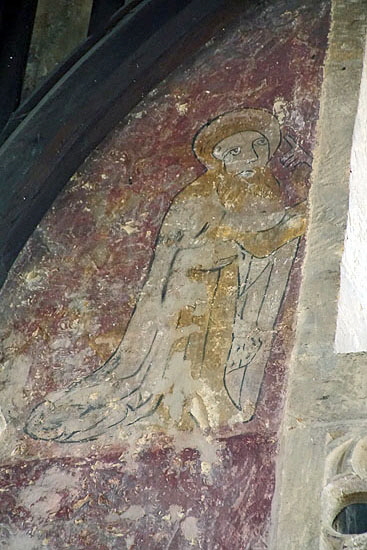 |
|||||||||||||||||||
|
Left: St Peter. Centre: St Paul. Right: The Early English south door |
|||||||||||||||||||
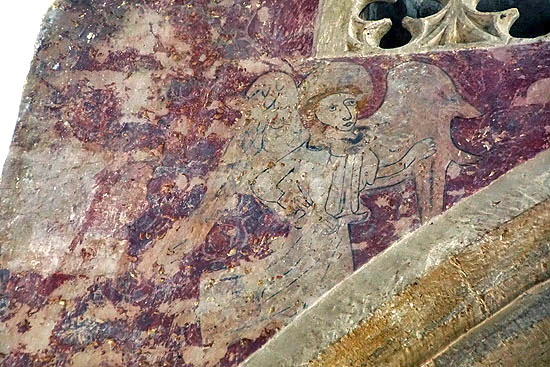 |
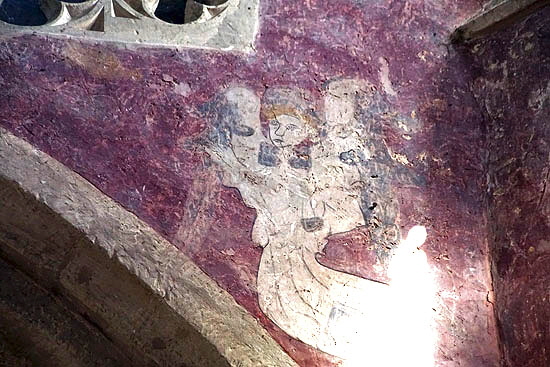 |
||||||||||||||||||
|
The angels here are rather grandiose specimens of the breed. |
|||||||||||||||||||
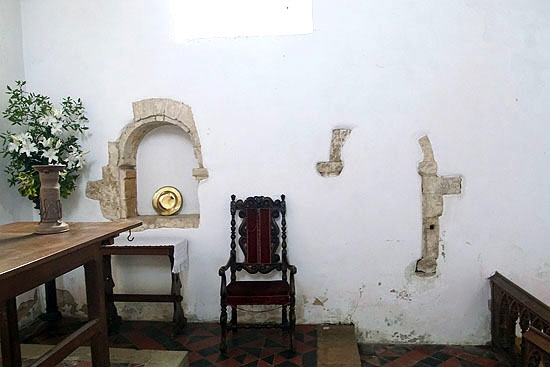 |
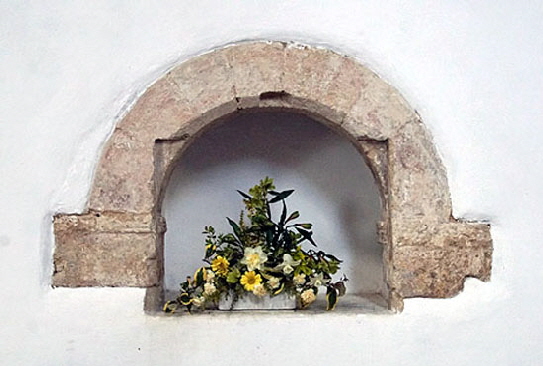 |
||||||||||||||||||
|
Left: As you would expect, the chancel has several Norman remnants and fragments. A piscina is to the left, I don’t know what has been filled in on the right. Right: Probably an aumbry cupboard and again clearly Norman. |
|||||||||||||||||||
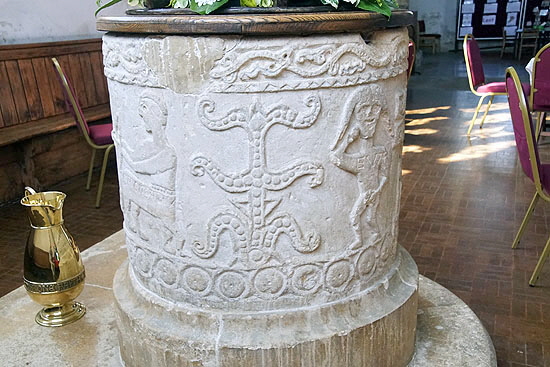 |
|||||||||||||||||||
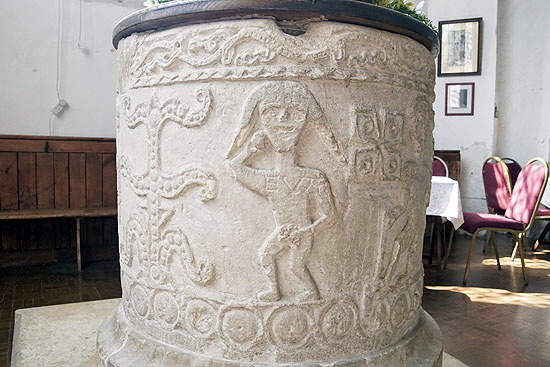 |
|||||||||||||||||||
|
And so to the font. Left: It’s a pretty competitive field, but this might just be the worst depiction of Eve on any English font. Just in case you should be unable to identify the original “fallen woman” the mason has helpfully carved her name in block capitals across where her bosom would have been had the sculptor known that women had bosoms. Eve’s hand covers what she now knows to be her naughty bits while her other hand grasps the apple. Right: The Tree of Knowledge. Or is the Tree of Life? Both are mentioned in Genesis and believe it or not Jewish scholars still can’t make out if there was one tree or two. The little spheres in the tree are probably meant to be apples. Note the interlace work at the top of the font and the medallion course at the bottom. |
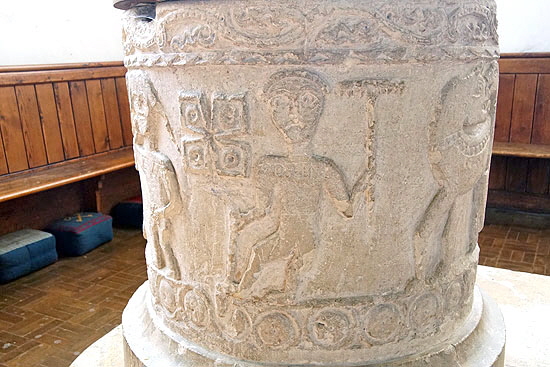 |
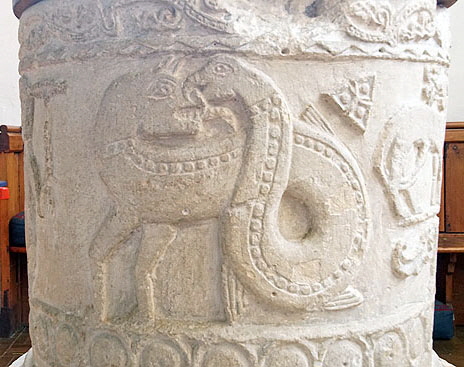 |
|
Left: Adam, the original naughty boy, labours after his fall. His name is also carved on his body. Right: This is supposed by the Church Guide to be the Serpent who is so in love with himself after his successful deception that he has decided to eat himself. Other sources call this an amphisbaena. Remember that word is could be useful in a whole variety of situations. Anyway, an amphisbaena was just like this: a legged creature with another head at the tail, as it were. When eggs were being hatched one head would sleep while the other looked after the eggs and when it was time to change round one end would wake the other. You would have to say that this image fits the description. It’s a bit of a coincidence its appearing alongside the Two Great Sinners and their tree so I suspect that the mason was just being a bit self-indulgent by making his serpent a bit ambiguous. |
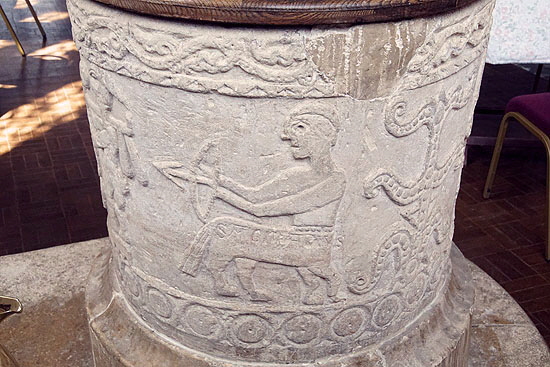 |
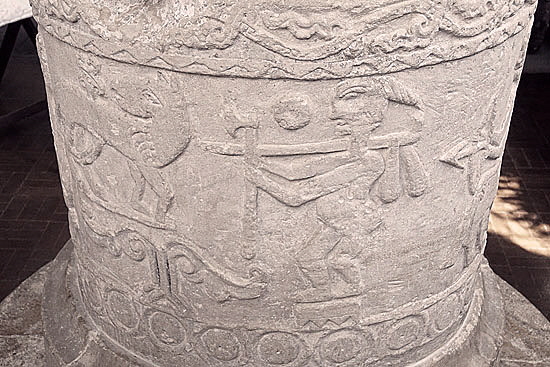 |
|||||
|
Left: The Norman preoccupation with Sagittarius above all the other signs of the zodiac is a bit of a mystery.. You can see other examples at Stoke-sub-Hamdon in Somerset and at Beckford in Worcesterhire, to name but two. As at Stoke-sub-Hamdon this Sagittarius has his name carved. Sagittarius is mentioned in the mediaeval Bestiaries and is reckoned to be at perpetual war with the “savage men” who lived on the “Plains of India”. The font at West Rounton in Yorkshire shows Sagittarius taking a potshot at what is presumably a save man’s head. There are other depictions of his shooting at lions and dragons which are generally taken as themes on the hoary old “good versus evil” allegory.. So who is he aiming his missiles at this time...? Right: Well, this is generally believed to be Aquarius who is about to flood the world. He has two water bags he is carrying over his shoulder and in one of his hands he carries an axe. Oddly, he has a horn on his head! I don’t think I would be unfair in saying that this interpretation is open to question but does anybody have a better explanation? Unfortunately the mason had abandoned his helpful habit of labelling his figures. |
||||||
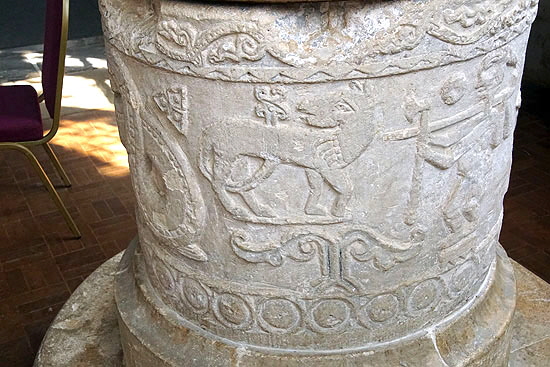 |
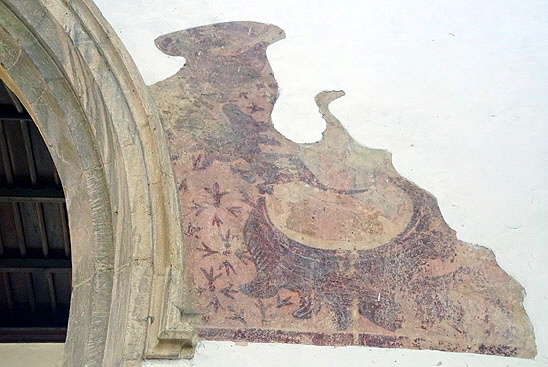 |
|||||
|
Left: This is presumed to be Leo although. Again there is no label. Right: A scrap of painting from the nave wall near the chancel arch. The Church Guide suggests it was part of a depiction of the Harrowing of Hell. |
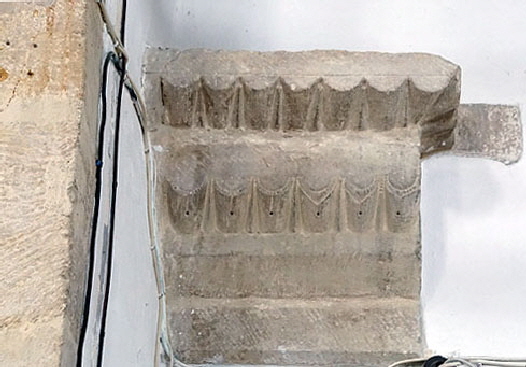 |
|||||||||||||||||||||
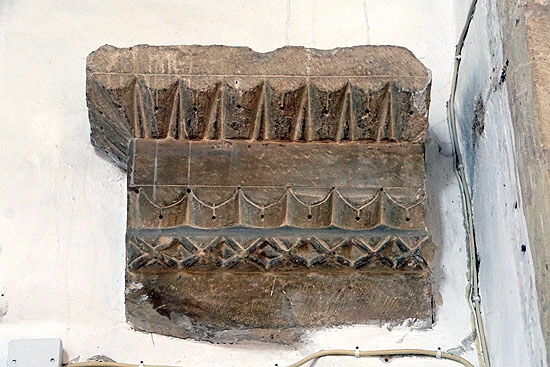 |
|||||||||||||||||||||
|
These two Norman capitals are marooned just east of the chancel arch, They may have been moved here but that seems a bit odd. Were they part of the original Norman chancel arch? |
|||||||||||||||||||||
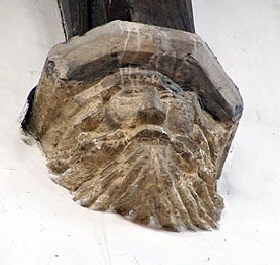 |
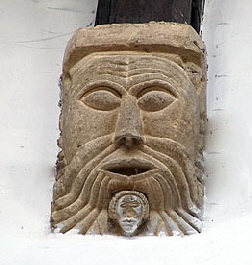 |
||||||||||||||||||||
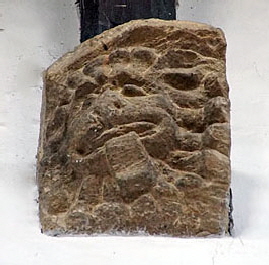 |
|||||||||||||||||||||
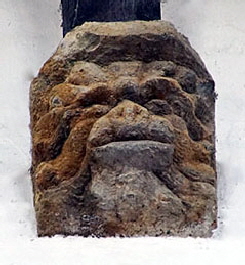 |
|||||||||||||||||||||
|
These are just four of a nice set of corbel carvings. There is a tongue-puller (second left). The one on the right is stylistically different and quite Norman-looking. Was it placed here subsequently? |
|||||||||||||||||||||
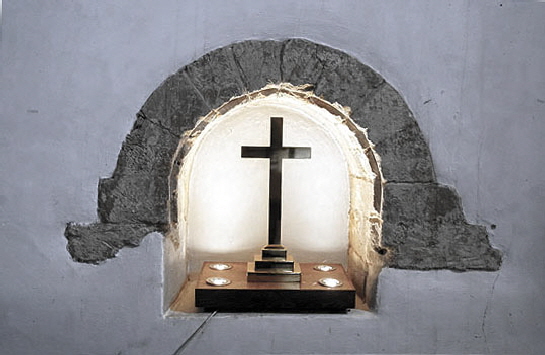 |
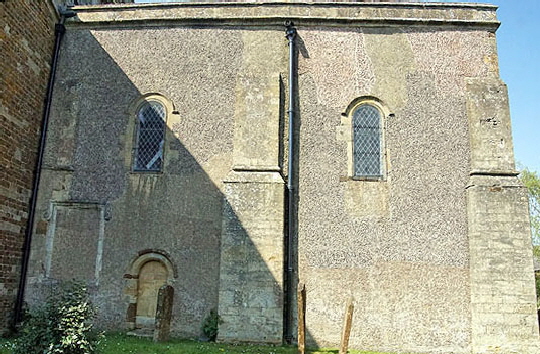 |
||||||||||||||||||||
|
Left: This little space near the altar is believed to have been a reliquary. Right: The south side of the chancel. The windows are original and there is a blocked Norman priest’s door. |
|||||||||||||||||||||
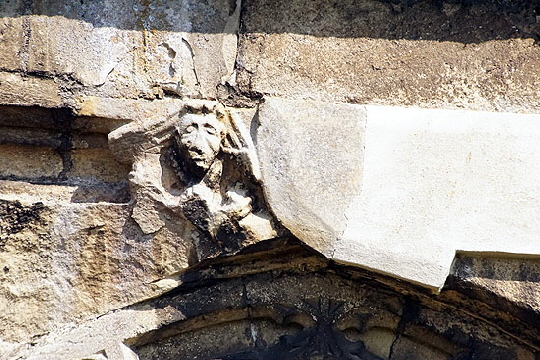 |
|||||||||||||||||||||
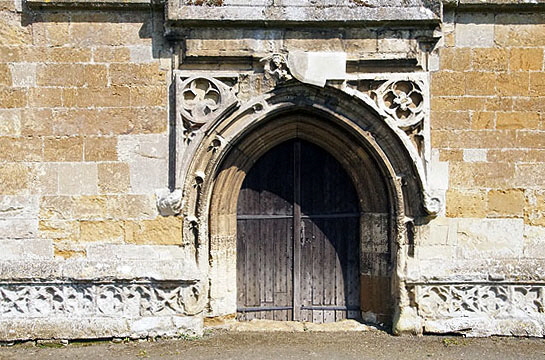 |
|||||||||||||||||||||
|
Left: The west door is quite elaborate in its decoration but the whole composition looks decidedly squat! Note the quatrefoil decoration that resembles that in the Cotswold window, Above the doorway is a curious carving shown in more detail in the picture right. |
|||||||||||||||||||||
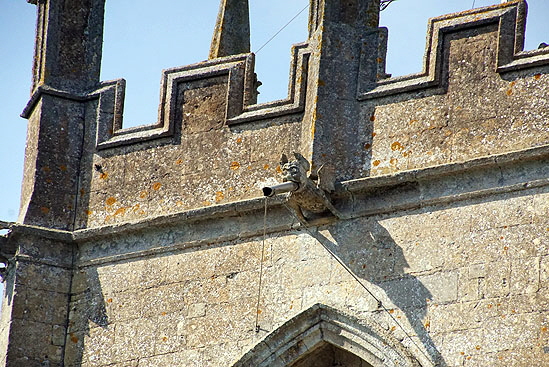 |
|||||||||||||||||||||
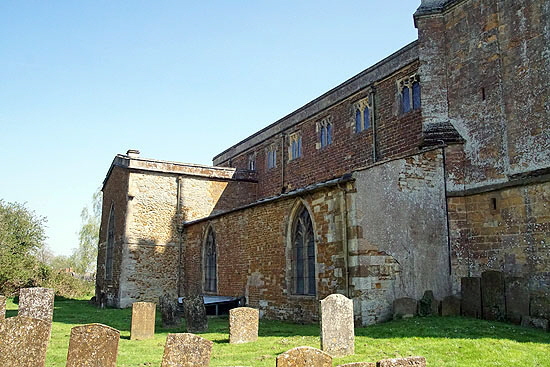 |
|||||||||||||||||||||
|
Left: The church from the north west. This view does nothing to redeem the feeling that the exterior is a bit of a mess architecturally. The transept is Norman but its roof has been raised. The nave was also raised in the fifteenth century or possibly the sixteenth. The raised transept roof constrained the height of the clerestory windows leaving a peculiarly large gap between it and the aisle roof. It has the unfortunate effect of making the aisle look like a lean-to shed bolted on the side of the church. The rendered windowless west end rather exacerbates the effect. The whole church is hopelessly asymmetrical. How would you ever guess how attractive the interior is? Right: The west tower, despite being somewhat incongruous architecturally was decently executed with the regulation battlements and pinnacles of the time and a decent set of gargoyles of which this is one. |
|
|
||||||||||||||||||||||||||||||||
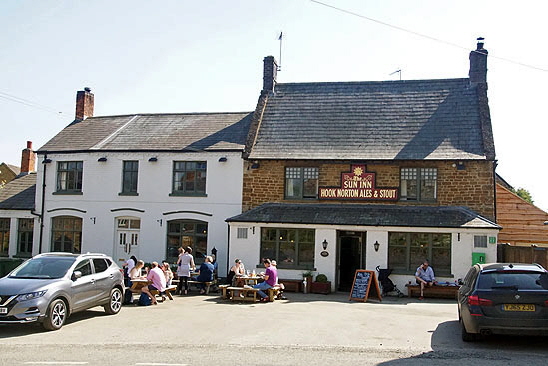 |
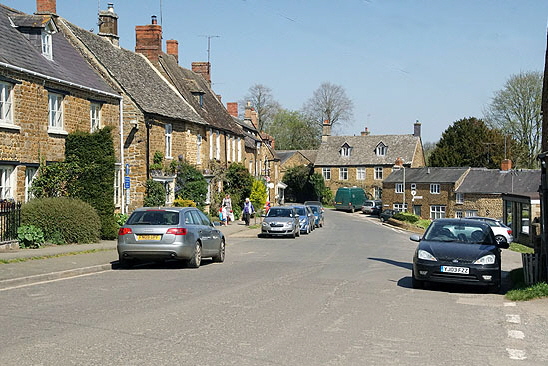 |
|
Left: The Sun Inn awaits your post-visit custom with its range of Hook Norton ales. It was a summer Saturday afternoon and there are few places nicer and more civilised than the beer garden of an English country pub on a sunny afternoon. Right: Hook Norton village. I have edited out the telephone wires! |
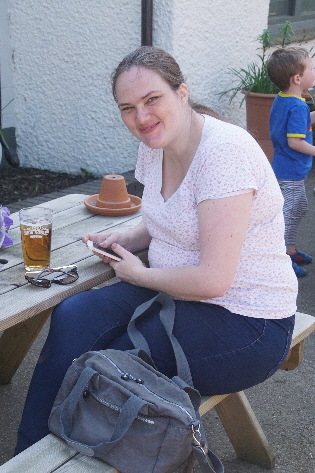 |
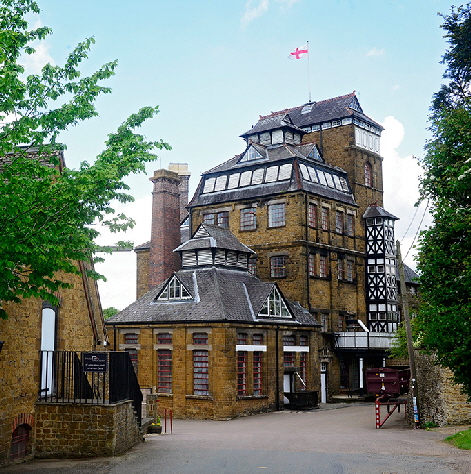 |
||||||||
|
Left: My beloved daughter, Kerry, minds her dad’s pint of Old Hooky that was brewed (Right) at the still-independent Victorian Hook Norton brewery. |
|||||||||
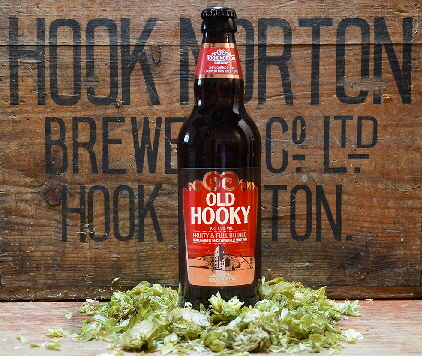 |
|||||||||
